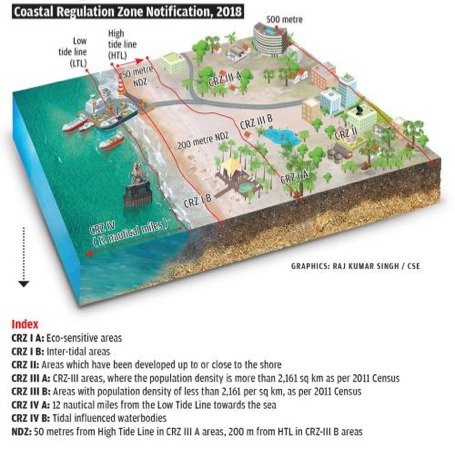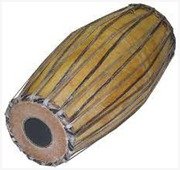Coastal Regulation Zone
- The coastal areas of seas, bays, creeks, rivers, and backwaters which get influenced by tides up to 500 m from the high tide line (HTL) and the land between the low tide line (LTL) and the high tide line have been declared as coastal regulation zone (CRZ) in 1991.
- The coastal regulation zones have been declared by the Ministry of Environment, Forest and Climate change under the Environment Protection Act 1986.

CRZ – I: Most ecologically sensitive areas like mangroves, coral reefs etc.
CRZ-II: Areas which are developed up to the shoreline and falling within the municipal limits; includes built-up area – villages and towns are that are already well established.
CRZ-III: Areas that are relatively undisturbed and do not fall under either in Category I or II and also include rural and urban areas that are not substantially developed.
CRZ-IV: It includes coastal waters extending up to 12 nautical miles.
Mridangam
- It is a classical drum of South Indian Music.
- Also known as medal or maddalam.
- It is one of the oldest Indian percussion instruments.
- It is a popular bifacial drum of Carnatic Music.
- A similar instrument, the pakhavaj, is played in the Hindustani tradition of northern India, as well as in Pakistan and Bangladesh.


Indian Classical Music
- Roots of Indian classical music can be traced back to its origin in the recital of Vedic hymns.
- There are four main Vedas, of which the one known as Samaveda (from saman, roughly translating to ‘melody’) is the most relevant – as the texts contained in it were clearly meant to be sung whilst also acting as treatises about music, dance and theatre.
- The seven swars of music – Sa, Re, Ga, Ma, Pa, Dha, Ni represent different scriptural deities: SA – Agni, RE – Brahma, GA – Saraswati, MA – Shiva, PA – Vishnu, DHA – Ganesha, NI – Surya
- Two types of Indian Classical Music:
| Hindustani Music | Carnatic Music |
| It originated in North India. It was influenced by foreign traditions | It originated in South India. No such foreign influence |
| No strong emphasis on kriti as in Carnatic | It is strongly kriti-based |
| No strict adherence to unity of raga, tala and Sruti as in Carnatic music | Unity of raga, tala and Sruti in every piece |
| Prevalence of significant number of gharanas | No such prevalence of gharanas |
| More importance to vocal than instruments | Equal importance to both |
| Various sub-styles of singing | Only one sub-style of singing |
